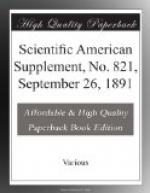--------+
Cast steel has been freely used by the writer for bends, junction pieces, etc., of steam pipes, as well as for steam valve chests; and except for the fact that steel makers’ promises of delivery are generally better than their performance, the result has thus far been satisfactory in all respects. These were adopted because there existed some doubt as to the strength of gun metal under a high temperature; and as the data respecting its strength appeared of a doubtful character, a series of careful tests were made to determine the tensile strength of gun metal when at atmospheric and higher temperatures. The test bars were all 0.75 in diameter, or 0.4417 square inch sectional area; and those tested at the higher temperatures were broken while immersed in a bath of oil at the temperature here stated, each line being the mean of four experiments. The result of these experiments was to give somewhat greater faith in gun metal as a material to be used under a higher temperature; but as steel is much stronger, it is probably the most advisable material to use, when the time necessary to procure it can be allowed.
Feed Heating.—With the double object of obviating strain on the boiler through the introduction of the feed water at a low temperature, and also of securing a greater economy of fuel, the principle of previously heating the feed water by auxiliary means has received considerable attention, and the ingenious method introduced by Mr. James Weir has been widely adopted. It is founded on the fact that, if the feed water as it is drawn from the hot well be raised in temperature by the heat of a portion of steam introduced into it from one of the steam receivers, the decrease of the coal necessary to generate steam from the water of the higher temperature bears a greater ratio to the coal required without feed heating than the power which would be developed in the cylinder by that portion of steam would bear to the whole power developed when passing all the steam through all the cylinders. The temperature of the feed is of course limited by the temperature of the steam in the receiver from which the supply for heating is drawn. Supposing, for example, a triple expansion engine were working under the following conditions without feed heating: Boiler pressure, 150 lb.;—indicated horse power in high pressure cylinder 398, in intermediate and low pressure cylinders together 790, total, 1,188; and temperature of hot well 100 deg. Fahr. Then with feed heating the same engine might work as follows: The feed might be heated to 220 deg. Fahr., and the percentage of steam from the first receiver required to heat it would be 12.2 per cent.; the indicated horse power in the high pressure cylinder would be as before 398, and in the intermediate and low pressure cylinders it would be 12.2 per cent,




